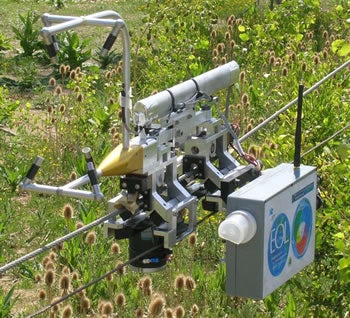TRAM
Status:
TRAM stopped being supported after 2010 and is now decommissioned.
 The TRAnsect Measurement (TRAM) system is a tool to investigate a variety of problems in which repetitive measurements of spatial gradients are required on scales of 1 - 200 m (primarily horizontal). Operating similar to an electric train, TRAM consists of one (or potentially more) instrumented trolley that traverses a fixed cable supported by a set of many towers. This allows TRAM to be deployed in complex terrain with rugged topography and obstacles. Various groups have constructed other cable-driven systems, however TRAM is unique in using more than 2 towers, so that transects can be constructed with quite large extents. Also, with a closed path, multiple trolleys may be operated simultaneously, reducing sampling errors and allowing divergence to be calculated continuously. Much of the support for this development has been provided by ESSL/TIIMES (now BEACHON), since it is a unique tool to sample within forest canopies, especially at night.
The TRAnsect Measurement (TRAM) system is a tool to investigate a variety of problems in which repetitive measurements of spatial gradients are required on scales of 1 - 200 m (primarily horizontal). Operating similar to an electric train, TRAM consists of one (or potentially more) instrumented trolley that traverses a fixed cable supported by a set of many towers. This allows TRAM to be deployed in complex terrain with rugged topography and obstacles. Various groups have constructed other cable-driven systems, however TRAM is unique in using more than 2 towers, so that transects can be constructed with quite large extents. Also, with a closed path, multiple trolleys may be operated simultaneously, reducing sampling errors and allowing divergence to be calculated continuously. Much of the support for this development has been provided by ESSL/TIIMES (now BEACHON), since it is a unique tool to sample within forest canopies, especially at night.
TRAM has been used in the NIWOT07 field project, NIWOT09 field project, and a 2012/2013 sensor test at NOAA's Boulder Atmospheric Observatory (BAO).